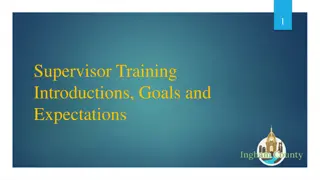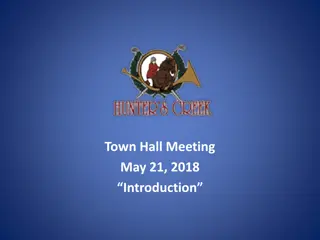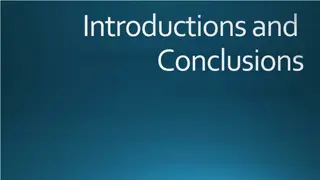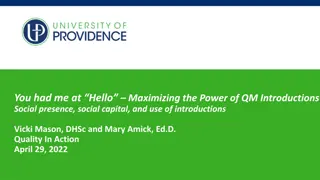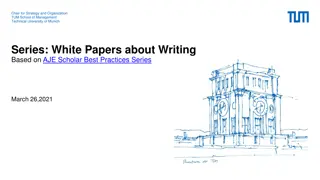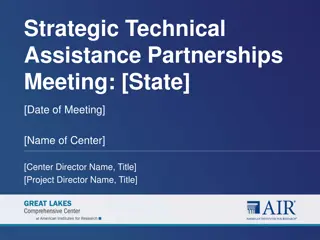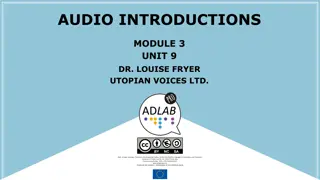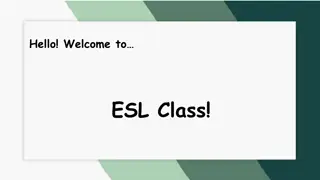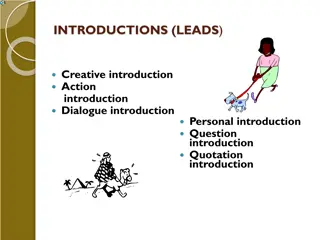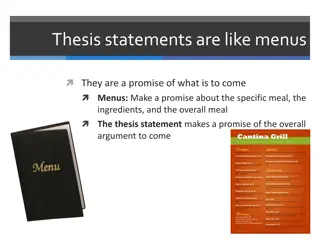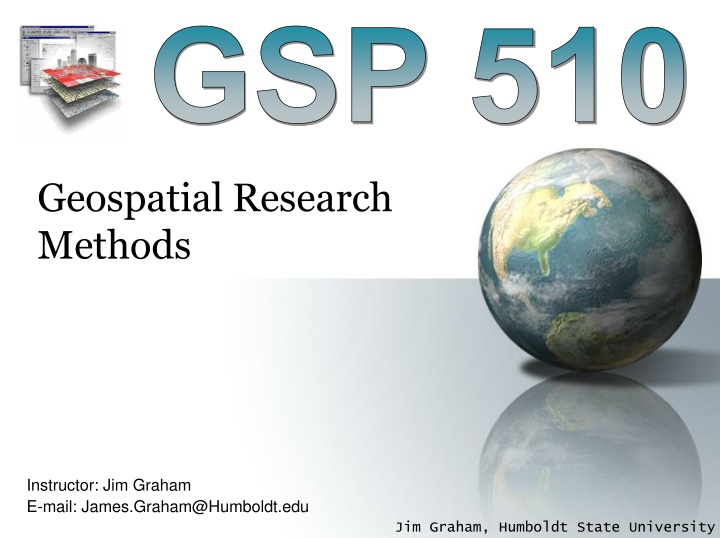
Geospatial Research Methods with Jim Graham at Humboldt State University
Explore the world of geospatial research methods with Jim Graham at Humboldt State University. This advanced class prepares graduate students for in-depth work in the field and covers essential basics for successful research with spatial data and methods.
Download Presentation

Please find below an Image/Link to download the presentation.
The content on the website is provided AS IS for your information and personal use only. It may not be sold, licensed, or shared on other websites without obtaining consent from the author. If you encounter any issues during the download, it is possible that the publisher has removed the file from their server.
You are allowed to download the files provided on this website for personal or commercial use, subject to the condition that they are used lawfully. All files are the property of their respective owners.
The content on the website is provided AS IS for your information and personal use only. It may not be sold, licensed, or shared on other websites without obtaining consent from the author.
E N D
Presentation Transcript
GSP 510 Geospatial Research Methods Instructor: Jim Graham E-mail: James.Graham@Humboldt.edu Jim Graham, Humboldt State University
About the class This is an introduction to how to properly use geospatial data and methods in research The class substitutes for GSP 101 and GSP 270 The class is for graduate students and thus the amount of work will be much higher than either of the other classes! This class will prepare you for GSP 216, GSP 316, GSP 370 and so on Jim Graham, Humboldt State University
Jim Graham Bachelor's in CS and Math from Chico State Over 20 years as a software engineer 15 with HP as an engineer and manager Owner of tecBugs and now SchoonerTurtles PhD from Colorado State U. in Forestry/GIS Eight years with the Natural Resource Ecology Laboratory at Colorado State Two years with Oregon State U. 17 years doing GIS, 8 years teaching GIS Research with: State Dept., USGS, USDA, DOE Jim Graham, Humboldt State University
But who am I really? Grew up loving the mountains of California Usually had a 24k topo in my back pocket Discovered computers Put together computers and maps to solve problems After over 20 years in the commercial world, returned to academia to teach and help improve decisions on how we interact with the natural world (because I am worried!) Jim Graham, Humboldt State University
Who are you? Jim Graham, Humboldt State University
This class is about Research with Spatial Data and Methods We will not cover everything you need to know to be successful We will cover the basics and how to learn what you need to know to be successful Federal regulations define research as "a systematic investigation, including research development, testing, and evaluation, designed to develop or contribute to generalizable knowledge" (45CFR46.102(d)). Jim Graham, Humboldt State University
Research Process Products Acquire/ Create Data QAQC Data Create Products Prep Data Analysis Jim Graham, Humboldt State University
What is a GIS? Geographic Information System Something (typically a computer) that provides information based on spatial data (locations of stuff) Includes: ? Jim Graham, Humboldt State University
What is GIS? A Geographic Information Science Using spatial data and analysis to create new information Also, what academics wish GIS stood for. Better Decisions Jim Graham, Humboldt State University http://data-informed.com/how-spatial-analysis-leads-to-insight/
Why are we here? Help get better careers Improve the world for all living things Jim Graham, Humboldt State University
Student Success (2017) Learning: 10 (knowledge, skills, accomplish tasks, projects, teamwork, communication, networking, perspectives, time management, getting help, tools) Career prep: 9 Healthy: 3 Monies worth: 2 Graduating: 1 Grades: 1 Jim Graham, Humboldt State University
Student Success Acquiring the skills, academic, professional, and interpersonal, that, when coupled with exposure to diverse perspectives and viewpoints encountered here, embolden students with agency and integrity to live in the world and make it a better place Robert Cowdrey What helps: Study habits, internships, research experience Faculty engagement: help seek help, understanding, respect Jim Graham, Humboldt State University
To Help Make Better Decisions Sept. 24, 2012 National Snow and Ice Data Center, 2012 Jim Graham, Humboldt State University
Antarctic Ozone Hole File:160658main2 OZONE large 350.png Largest Antarctic Ozone Hole September 2006 Jim Graham, Humboldt State University
Who's using GIS? Bolstad: From Archeology to Zoology Jim Graham, Humboldt State University
GIS is about: Providing information and answering questions With: Reports Maps Posters Web sites From: Spatial and a-spatial data Jim Graham, Humboldt State University
Anything else you need from me? Visual resources In-class demos (no death by ppt) Non-critical learning environ. Hands on Clear expectations Research examples Repetition of key concepts Interpret data Feedback Practical apps Personal experiences Organize data Map mobile sediments, social science GIS Software Make maps Assesible Useful supplemental materials GIS resources Jim Graham, Humboldt State University
The Class Materials Class web site: All the content gsp.humboldt.edu -> Online Learning -> GSP 510 Canvas: Assignments Grades Additional material will be presented in lab and lecture attendance is critical! I cannot cover all the material in class. You ll need to read ahead, ask questions, and review the material again. Jim Graham, Humboldt State University
Class Organization The schedule is organized by Online Learning Modules divided into weeks Each week: Review the web site over the weekend and do the indicated readings and activities Meet twice a week for presentations / discussions Start your lab on Tuesday and get it done by Friday! Turn it in the following Tuesday and so on Quizzes periodically instead of tests During the final time, you ll be presenting projects Jim Graham, Humboldt State University
To be successful Turn in lab assignments on time! Attend class, do the readings, etc. Ask questions on confusing topics Make good decisions Follow the 20 minute rule: If you re stuck more than 20 minutes, get help What is your learning style? www.vark- learn.com/english/page.asp?p=questionnaire Jim Graham, Humboldt State University
Working Together Technology is moving really fast However, society is not keeping up We need norms so we can work together constructively Respecting everyone is key To communicate effectively, you have to communicate from the other persons perspective Remember, you re sitting in a room of potential collaborators Jim Graham, Humboldt State University
Professionalism Turn off phones (and other electronics things you are carrying) or set to vibrate Make it to class on time, If you need to, set your alarm 20 minutes early! If you re late, please come in quietly If you need to leave during class Let me know ahead of time and sit by the door If you have a question, ask Others may be wondering about the same topic Jim Graham, Humboldt State University
Communication I communicate primarily through email and in person Email: Yo, what assignment. Sent from my iPhone It s easy to miss-read emails and hard to ask them clarifying questions Jim Graham, Humboldt State University
Emails Proper subject line Provide context so the reader understands the message Provide a formal signature For important emails, I write them and then re- read them later For emotionally-charged emails, I write them, re-write them, have someone review them, and then don t send some of them. Instead, I ll go out to lunch with the person Jim Graham, Humboldt State University
Bottom Line The more time you spend working with a GIS, the better you will do If you work hard and do the assignments on time Me (and others) will be there to help you when needed You just need to ask! Be ready to help others as well Jim Graham, Humboldt State University
A few other things There will be a lab assigned this week and due next week! Don t forget to do the readings for this week Jim Graham, Humboldt State University





